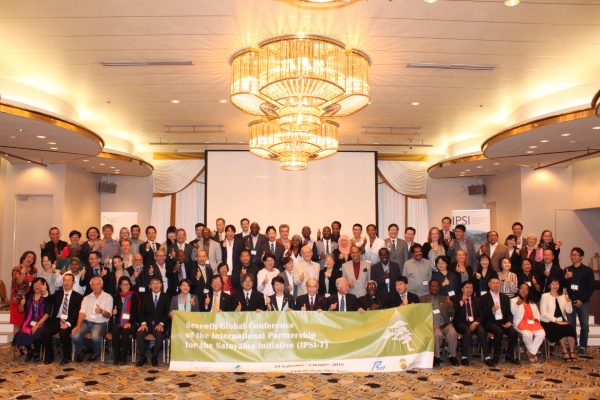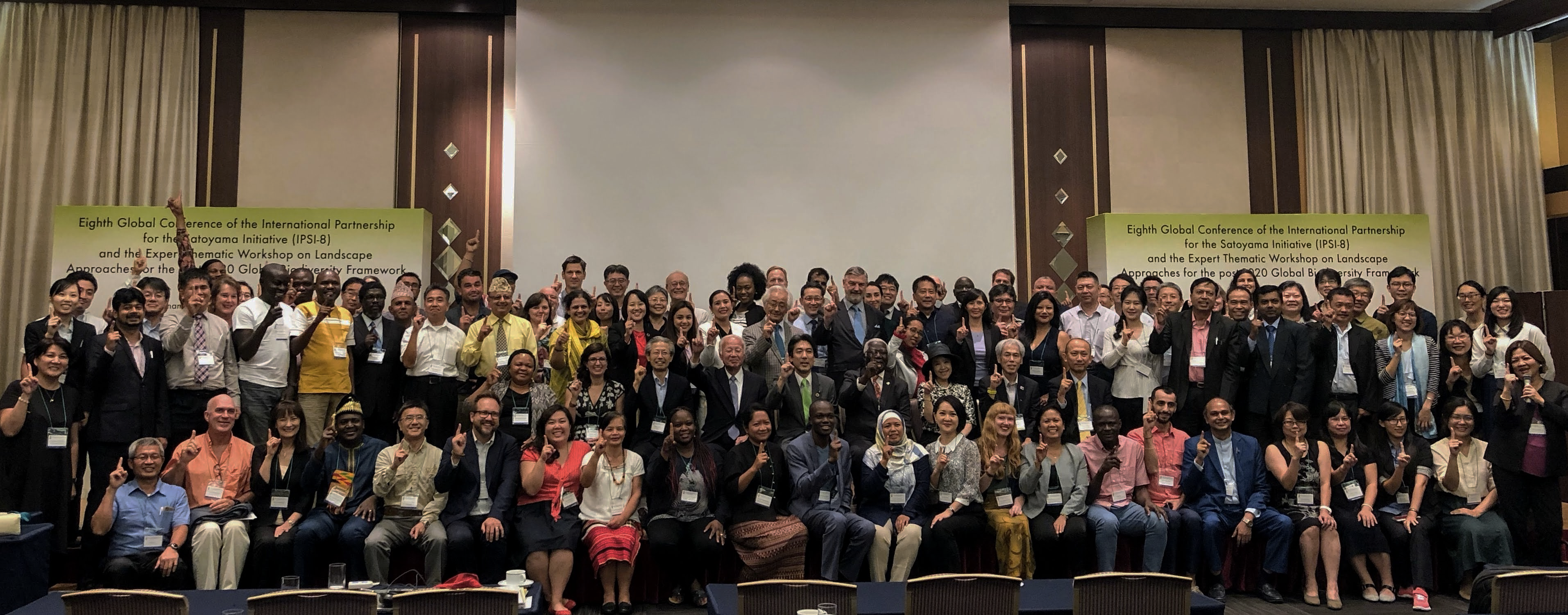The IPSI-7 Summary Report and Presentation Abstracts is now available for download here.

Participants of IPSI-7
The IPSI Secretariat and the Ministry of the Environment, Japan, organized the Seventh Global Conference of the International Partnership for the Satoyama Initiative (IPSI-7) in Kanazawa, Ishikawa Prefecture, Japan from 30 September – 2 October 2018, hosted by the Ishikawa Prefectural Government.
The IPSI-7 conference consisted of two main events: a meeting of the IPSI General Assembly and a Public Forum. The Public Forum was open to the general public, held on Sunday 30 September, 2018. The Public Forum is an opportunity for non-members to learn about IPSI and its activities as well as a venue for discussion of various topics related to socio-ecological production landscapes and seascapes (SEPLS), their revitalization and sustainable management. The theme of this year’s Public Forum was “Assessing the Satoyama Initiative’s Contributions towards Achieving the Aichi Biodiversity Targets and Sustainable Development Goals”. Experts from within Japan and around the world were invited to share a wide range of knowledge on the Satoyama Initiative and related processes including assessment processes under the Intergovernmental Science-Policy Platform on Biodiversity and Ecosystem Services (IPBES).
The General Assembly was held on Monday 1 October, open to IPSI members. The programme included information sharing and decisions regarding the future direction of IPSI, with working group sessions held for in-depth discussion of ongoing and potential contributions to the Convention on Biological Diversity’s Strategic Plan for Biodiversity 2011-2020 with its Aichi Biodiversity Targets, the United Nations’ Sustainable Development Goals, and others. Participants shared a large number of indicators used for assessment of activities towards achieving these global goals, and advice for how to ensure IPSI’s relevance in the post-2020 global biodiversity framework, expected to be adopted at the Fifteenth Conference of the Parties to the Convention on Biological Diversity, to be held in China in 2020.
On Tuesday 2 October, participants took part in an excursion to the Noto Peninsula to get a first-hand look at Japan’s satoyama and satoumi landscapes and seascapes, hosted by the Ishikawa Prefectural Government with significant support by the UNU-IAS Operating Unit Ishikawa/Kanazawa (OUIK).
Programme: IPSI-7 Public Forum
OPENING REMARKS
- Kazuhiko Takemoto, Director of the United Nations University Institute for the Advanced Study of Sustainability
- Yutaka Shoda, Director General, Nature Conservation Bureau, Ministry of the Environment, Japan
- Masanori Tanimoto, Governor of Ishikawa Prefecture (read by Mr. Hideo Yoshizumi, Director General, Planning and Development Department, Ishikawa Prefectural Government)
KEYNOTE SPEECHES
- “Satoyama Initiative’s Contributions towards Aichi Biodiversity Targets and SDGs”, Kazuhiko Takeuchi, Senior Visiting Professor, UNU-IAS; Director and Project Professor, IR3S at the University of Tokyo; President, Institute for Global Environmental Strategies (PPT)
- “An Overview the IPBES Global Assessment of Biodiversity and Ecosystem Services”, Prof. Eduardo Brondizio, Professor, Anthropology Department, Indiana University; Co-chair, Global Assessment of Biodiversity and Ecosystem Services, IPBES (PPT)
PANEL SESSION
- “Multiscale Scenarios for Nature Futures”, Dr. Simon Ferrier, Senior Principle Research Scientist, Commonwealth Scientific and Industrial Research Organization, CSIRO; Honorary Professor, Australian National University; Honorary Fellow, UNEP-WCMC (PPT)
- “COMDEKS Programme: Community action to achieve the Aichi Biodiversity Targets”, Ms. Yoko Watanabe, Project Manager, United Nations Development Programme (PPT)
- “Japan Network for Promoting the Satoyama Initiative, JNPSI”, Mr. Shinjiro Sasaki, Secretariat of Japan Network for Promoting the Satoyama Initiative; Nature and the Environment Division, Fukui Prefectural Government (PPT) and Mr. Yoshinori Miyahara, Biodiversity Biwako Network; Quality Control Group, Sekisui Jushi Corporation (PPT)
- “Activities for Sustainable Conservation of Satoyama in Suzu City” Dr. Daisuke Utsunomiya, Researcher, Sustainable Society and Ecosystems Office, Suzu City; Cooperative Researcher, Institute of Nature and Environmental Technology, Kanazawa University (PPT)
- Moderator: Hiroaki Takiguchi, Project Director, United Nations University Institute for the Advanced Study of Sustainability; Director, Secretariat of the International Partnership for the Satoyama Initiative
Programme: IPSI-7 General Assembly
IPSI-7 General Assembly Participants list
Agenda:
- Opening
- Selection of the Chair of the IPSI-7 General Assembly
- Agenda Item 1: Adoption of the Agenda
- Agenda Item 2: Report from the Chair of the IPSI Steering Committee
- Newly approved members
- Newly endorsed collaborative activities
- Agenda Item 3: Report from the Director of the IPSI Secretariat
- Agenda Item 4: Assessment of IPSI’s Contributions to the Aichi Biodiversity Targets and SDGs
- Working group and plenary sessions
- Agenda Item 5: Endorsement of the Ishikawa Statement
- Agenda Item 6: Next IPSI Global Conference
- Agenda Item 7: Other Matters
- Closing
Opening Plenary
OPENING REMARKS
- Kazuhiko Takemoto, Director of the United Nations University Institute for the Advanced Study of Sustainability
- Naomi Tokashiki, State Minister of the Environment, Japan
WELCOME REMARKS
- Masanori Tanimoto, Governor of Ishikawa Prefecture
VIDEO MESSAGE
- Cristiana Pașca Palmer, Executive Secretary, Secretariat of the Convention on Biological Diversity (YouTube link)
Working Groups
Group 1: CBD Strategic Goal A: Reduce the direct pressures on biodiversity and promote sustainable use
Facilitators:
- Yoko Watanabe, United Nations Development Programme
- Anil Kumar, M. S. Swaminathan Research Foundation
Abstracts and presentation files:
- Mordecai Ogada, Conservation Solutions Afrika: “Use of Mobile Technology for assessments of Community and Wildlife Use of Rangeland Resources in Laikipia, Kenya” (abstract) (PPT)
- Harold Chisale, Lilongwe University of Agriculture and Natural Resources: “Enhanced Biodiversity through timber out-grower schemes in Malawi” (abstract) (PPT)
- Guido Gualandi, Ancient Grains Association Montespertoli: “Ancient Grains Varieties provide new livelihood in Tuscany, Italy” (abstract) (PPT)
- Anara Alymkulova, “Institute for Sustainable Development Strategy” Public Foundation: “Community-Based Pasture Conservation: A Case of Kyrgyzstan” (abstract) (PPT)
- James H Seyani, National Herbarium & Botanic Gardens of Malawi: “Conservation of Plant Diversity in Agro-Ecological Production Landscape in Malawi” (abstract)
- Sarnaik Jayant: “Saving forests for business, climate and communities in the northern Western Ghats of India” (abstract)
(* Lead authors’ names only are listed above.)
Group 2: CBD Strategic Goal B: Address the underlying causes of biodiversity loss by mainstreaming biodiversity across government and society
Facilitators:
- Dorothy Nyingi, Kenya Wetlands Biodiversity Research Group
- Devon Dublin, Conservation International Japan
Abstracts and presentation files:
- Josea Sagbo Dossou Bodjrenou, Nature Tropicale NGO: “Community Integrated Management Of Migratory Species (West African Manatee And Sea Turtles) And Their Habitat In The Coastal Region In Benin” (abstract) (PPT)
- Inocencio Buot, University of the Philippines Open University: “Developing a Localized and Area-based Conservation Priority Setting of the Useful Plants among Alangan Mangyans of Halcon Range, Mindoro Island, Philippines” (abstract) (PPT)
- Uma Khumairoh, Integrated Organic Farming Systems Research Centre, University of Brawijaya: “Complex Rice Systems” (abstract) (PPT)
- Bishnu Pandit, Kathmandu Forestry College: “Building village economies through climate farming & forest gardening (BeChange)” (abstract) (PPT)
- Prasert Trakansuphakon, Pgakenyaw Association for Sustainable Development (PASD); Intermountain Peoples Education and Culture in Thailand (IMPECT): “IMPECT- GEF-Satoyama Project, Thailand” (abstract)
- Jeeranuch Sakkhamduang, Institute of Environmental Rehabilitation and Conservation (ERECON): “Scaling up lessons: promoting sustainable agriculture in Cambodia” (abstract)
(* Lead authors’ names only are listed above.)
Group 3: CBD Strategic Goal C: To improve the status of biodiversity by safeguarding ecosystems, species and genetic diversity
Facilitators:
- Yoji Natori, Conservation International
- Andre Mader, Institute for Global Environmental Strategies (IGES)
Abstracts and presentation files:
- Yiching Song, Centre for Chinese Agricultural Policy, Chinese Academy of Science: “Farmers’ Seed System Enhancement and Traditional Knowledge Revitalization for Climate Change Adaptation in 3 Naxi Mountainous Communities in Yunnan, Southwest China” (abstract) (PPT)
- Seth Appiah-Kubi, A Rocha Ghana: “Empowering Local Communities to Protect Threatened Socio-Ecological Production Landscapes and Seascapes (SEPLS)” (abstract) (PPT)
- Kien Dang, Community Entrepreneur Development Institute (CENDI): “Restoration and Extension Plantings after SDM” (abstract) (PPT)
- Anatolii Lebedev, NGO BROC: “Bikin: 30 years battle for conservation” (abstract) (PPT)
- Jung-Tai Chao, SWAN International: “Transformations towards sustainability – A SEPLS restored by the Gongrong community” (abstract)
- Gerald Jetony, Natural Resource Office, Sabah: “Introduction of incentives for control activities within water conservation area-study on community readiness for payment for ecosystem services (PES) in Babagon, Penampang, Sabah” (abstract)
(* Lead authors’ names only are listed above.)
Group 4: CBD Strategic Goal D: Enhance the benefits to all from biodiversity and ecosystem services
Facilitators:
- William Olupot, Nature and Livelihoods
- Hydie Maspias, Help Davao Network: “Vulnerability Assessment of the Urban Water Supply System of Davao City, Southern Philippines” (abstract)
Abstracts and presentation files:
- Yu-Chun Chan, Tse-Xin Organic Agriculture Foundation: “Organic Value Chain Development of Indigenous Communities in Eastern Taiwan” (abstract) (PPT)
- Pua’ala Pascua, American Museum of Natural History: “At the intersection of global goals and local well-being: A lens from the Pacific Islands” (abstract) (PPT)
- Chemuku Wekesa, Kenya Forestry Research Institute: “Restoration of Sacred Kaya forests in Kenyan Coast for enhanced provision of ecosystem services and products for improved livelihoods” (abstract) (PPT)
- Dipayan Dey, South Asian Forum For Environment: “Aquaculture of Native Alga in Inundated Coastal Farmlands: A Pro-poor Climate Adaptive Intervention for Restoring Ecosystem Services” (abstract) (PPT)
- Hiu Lai Katie Chick, The Policy for Sustainability Lab (PSL), Faculty of Social Sciences, the University of Hong Kong: “Rural Sustainability Programme in Lai Chi Wo, Hong Kong” (abstract)
- Rashed Al Mahmud Titumir, Unnayan Onneshan: “Promotion of Customary Sustainable Use of Biodiversity and Ecosystem Services in the Sundarbans” (abstract)
(* Lead authors’ names only are listed above.)
Group 5: CBD Strategic Goal E: Enhance implementation through participatory planning, knowledge management and capacity building
Facilitators:
- Maurizio Farhan Ferrari, Forest Peoples Programme
- Wataru Suzuki, Secretariat of the Convention on Biological Diversity
Abstracts and presentation files:
- Dayuan Xue, Minzu University of China: “Facilitating the implementation of Nagoya Protocol through Documentation of Traditional Knowledge Associated with Genetic Resources in China” (abstract) (PPT)
- Samuel Ojelel, Save A Seed For The Future: “Use of wild edible plants in the forest reserves of Teso-Karamoja region, Uganda” (abstract) (PPT)
- Onel Masardule, Foundation for the Promotion of Indigenous Knowledge: “Contribution of biocultural territories for the conservation and sustainable use of biodiversity” (abstract) (PPT)
- Florence Daguitan, Tebtebba: Indigenous Peoples’ International Centre for Policy Research and Advocacy: “Increasing Community Resilience for Food Security” (abstract) (PPT)
- Yaw Osei-Owusu, Conservation Alliance International: “Making Landscapes Work- A Case of the Kakum Conservation Area” (abstract)
- Ruth Spencer, Marine Ecosystems Protected Area Trust: “IPLC voices from Antigua and Barbuda in various CBD processes” (abstract)
(* Lead authors’ names only are listed above.)



